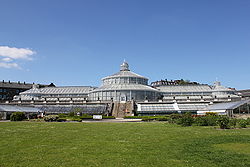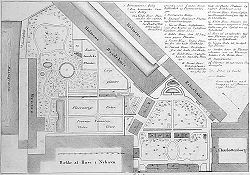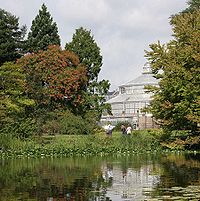- University of Copenhagen Botanical Garden
-
University of Copenhagen Botanical Garden 
The Palm House from 1874Type Botanic Garden Location Copenhagen, Denmark Coordinates 55°41′13″N 12°34′26″E / 55.68694°N 12.57389°ECoordinates: 55°41′13″N 12°34′26″E / 55.68694°N 12.57389°E Area 10 hectares Created 1600 (founded)
1870 (current location)Operated by University of Copenhagen Status Open all year The University of Copenhagen Botanical Garden (Danish: Botanisk have), usually referred to simply as Copenhagen Botanical Garden, is a botanical garden located in the centre of Copenhagen, Denmark. It covers an area of 10 hectares and is particularly noted for its extensive complex of historical glasshouses dating from 1874.
The garden is part of the Natural History Museum of Denmark, which is itself part of the University of Copenhagen Faculty of Science. It serves both research, educational and recreational purposes.
Contents
History
The botanical garden was first established in 1600 but it was moved twice before it was ultimately given its current location in 1870. It was probably founded to secure a collection of Danish medicinal plants after the Reformation had seen many convents and their gardens abandoned or demolished.[1]
The first garden: Hortus Medicus
The first garden, known as Hortus Medicus, was created on 2 August 1600 by royal charter on a piece of land donated by the king, Christian IV. It was located in Skidenstraede (present-day Krystalgad) and a residence for one of the professors of the university was also built at the site. It rested upon the professor in residence to maintain the garden, irrespective of which chair he held. In 1621 Ole Worm personally took over the responsibility for the garden and he enriched it with a great number of Danish medicinal plants as well as rare foreign species he received from his many professional contacts abroad.[2]
Oeder's Garden
A second botanical garden was laid out by Georg Christian Oeder in 1752 in the newly founded Frederiksstaden district at the request of Frederik V at a site bisected by Amaliegade just north of Frederik's Hospital. The smaller western section, covering just under half a hectare, was equipped with a greenhouse while the eastern section remained largely unplanted. The garden was opened to the public in 1763.
In 1770 part of Oeder's Garden was put at the disposal of the University's botanical garden. The preceding year Christian VII had donated 2,500 thaler to the University, the interest from which would be used for the Botanical Garden. This had created the economical foundation for an enlargement but since there was no space for it at its original address, the off-site solution was ultimately opted for.[3]
Oeder became the Botanical Garden's first director. In order to emphasise its economic significance, as well as in the spirit of the Age of Enlightenment, he began a work in progress which was to become Flora Danica, an illustrated work describing all Danish and Norwegian plants. Oeder was fired in 1771 in connection with the Johann Friedrich Struensee affair.
The Charlottenborg Garden
In 1778 both gardens were closed when the king reacquired the land at Amaliegade and at the same time donated a tract of land behind Charlottenborg Palace for the establishment of a new and larger botanical garden. Plans for this garden received royal approval on 22 July 1778. It was to have two directors, one appointed by the University and the other by the King. The first University appointment to this post was Christian Friis Rottbøll, who had already managed the garden since Oeder's retirement, and the first royal appointment was Johan Theodor Holmskjold. At the same event, an associate professor was employed at the garden. The first to hold this chair was Martin Vahl, who played a large part in moving the plants from Oeder's Garden to Charlottenborg Garden.
In 1817, the model with a double directorship was abandoned when Jens Wilken Hornemann was made the sole director of the garden. At this stage the garden encompassed approximately 1.6 hectares in a low, waterlogged area that was bounded by Charlottenborg, Nyhavn, the Mint and Bremerholm. A main building was erected along the Nyhavn cabal, housing both a botanical museum, a library and residences for the director and a botanical gardener. There were also facilities for the storage of sensitive plants during winter. The garden's first greenhouse, Guiones Koldhus (Guione's Coolhouse), was erected in 1784. In 1803 the king funded of a new 200 sqm complex of greenhouses and nore were added in 1837.
In 1841 Joakim Frederik Schouw replaced Hornemann as director and the garden. Among his initiatives was the establishment of a new section dedicated to Danish species, holding 570 species, and improved cataloguing of plants and seeds. His tenure lasted until 1852. During this phase the garden became still more cramped and it became evident that another expansion was needed.
The current garden
The botanical gardens got its current location in 1870. Four years later in 1874 the gardens got its large complex of glasshouses at the initiative of Carlsberg founder J. C. Jacobsen who also funded it. His inspiration was that of the glass building the Crystal Palace that was erected for the Great Exhibition in London in 1851.[4]
In 1977, the gardens including the greenhouses became listed by the Danish conservation authorities.
Copenhagen Botanical Garden today
Copenhagen Botanical Garden is an informal garden with free admission. There are conservatories, a museum and herbarium, a library (admission by appointment only) a shop plants, seeds and a small selection of garden equipment and eating place.
Collections
The botanical gardens contain more than 13,000 species, almost all of which have been collected in the wild. The garden is arranged in different sections including: Danish plants (600 species), perennial plants (1,100 species), annual plants (1,100 species), rock gardens with plants from mountaineous areas in Central and Southern Europe and Conifer Hill which is planted with coniferous trees. One of the newest inclusions is a rhododendron garden
The garden has many handsome specimen trees.[5] The oldest tree in the gardens is a taxodium from 1806 that was moved along from the old location at an age of 60 years.[6]
Glasshouses
The Gardens have 27 glasshouses. The most notable are the 3000 sqm conservatory complex from 1874. The Palm House at its centre is 16 metres tall and has narrow, cast-iron spiral stairs leading to a passageway at the top. Plants include a palm from 1824 and a fine collection of cycads, some ogf which are more than 100 years old. A fifty metres long glasshouse house an extensive collection of cacti and other succulents whilst another one houses orchids and begonias.[7] A modern glasshouse is dedicated to caudiciforms. The garden also has a special air-conditioned greenhouse that can re-create environments suitable for Arctic plants.[8]
Museum and seed bank
The university’s botanical museum and herbarium are housed in a building situated within the garden, giving the garden staff ready access to reference works and more than 2 million dried plant specimens.[9]
Surrounding buildings
Social Sciences Faculty Library
Located at 140 Gothersgade, the building was designed by Johan Daniel Herholdt and built from 1888 to 1890 as botanical Laboratory. It is a Historicist building inspired by Italian palazze, a style which Herholt had previously relied on in his now demolished National Bank at Holmens Kanal. The building has housed the faculty library of the Faculty of Social Sciences since 2011.[10]
Institute of Psychology
Institute of Psychology, at 2A Øster Farimagsgade, is based in a building which was built on 1957 to the design of Kai Gottlob for the Institute of Biology at University of Copenhagen.
See also
- Parks and open spaces in Copenhagen
External links
- Official webpage
- History and restoration, pdf about the garden
References
- ^ "Botanisk Have". Danmarks Naturfredningsforening. http://www.dn.dk/Default.aspx?ID=3330. Retrieved 2009-04-06.
- ^ "The first garden". University of Copenhagen. http://botanik.snm.ku.dk/english/Ombhm/Havens_historie/foersteandenhave/. Retrieved 2010-02-24.
- ^ "The second and third Botanic Garden". University of Copenhagen. http://botanik.snm.ku.dk/english/Ombhm/Havens_historie/andenhave/. Retrieved 2010-02-24.
- ^ "Botanisk Have". AOK. http://www.aok.dk/byen-rundt/botanisk-have. Retrieved 2009-04-06.
- ^ "University of Copenhagen Botanical Garden". Encyclopædia Britannica. http://www.britannica.com/EBchecked/topic/136545/Copenhagen-University-Botanical-Garden. Retrieved 2009-04-06.
- ^ "Botanisk Have". Danmarks Naturfredningsforening. http://www.dn.dk/Default.aspx?ID=3330. Retrieved 2009-04-06.
- ^ "University of Copenhagen Botanical Garden". Encyclopædia Britannica. http://www.britannica.com/EBchecked/topic/136545/Copenhagen-University-Botanical-Garden. Retrieved 2009-04-06.
- ^ "University of Copenhagen Botanical Garden". Encyclopædia Britannica. http://www.britannica.com/EBchecked/topic/136545/Copenhagen-University-Botanical-Garden. Retrieved 2009-04-06.
- ^ "University of Copenhagen Botanical Garden". Encyclopædia Britannica. http://www.britannica.com/EBchecked/topic/136545/Copenhagen-University-Botanical-Garden. Retrieved 2009-04-06.
- ^ "Botanisk Laboratorium, Københavns Kommune" (in Danish). Kulturarvsstyrelsen. http://www.kulturarv.dk/fredede-bygninger/fredning/fredninger-i-hoering/botanisk-laboratorium-koebenhavns-kommune/. Retrieved 2001-09-30.
Amager Vest Amager Øst Amager Strandpark · Kløvermarken · Lergravsparken · Prags BoulevardBispebjerg Bispebjerg Cemetery · NordvestparkenBrønshøj-Husum Bellahøjparken · Brønshøjparken · Degnemosen · Husumparken · Kagsmosen · Krogebjergparken · Rødkildeparken · Utterslev MoseFrederiksberg Frederiksberg Park · Royal Danish Horticultural Society's Garden · Solbjerg Park Cemetery · Søndermark Cemetery · SøndermarkenNørrebro Valby Baunehøjparken · Carl Jacobsen Garden · Damhusengen · J. C. Jacobsen Garden · ValbyparkenVesterbro/Kgs. Enghave Østerbro Churchillparken · Classens Have · Fælledparken · Garnisons Cemetery · Holmens Cemetery · Kastellet · Langelinieparken · Mindelunden · Ryvangens Naturpark · Svanemølle BeachCategories:- Botanical gardens in Denmark
- Parks in Copenhagen
Wikimedia Foundation. 2010.





